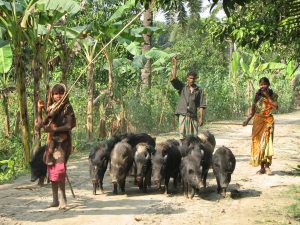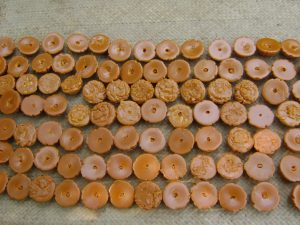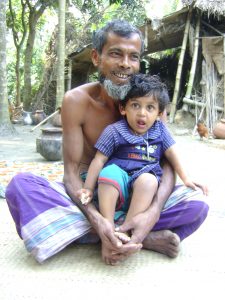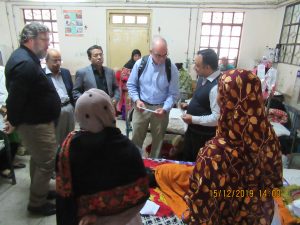The Nipah Vaccine Project
Nipah Disease Background

Pig raisers in village. Photo courtesy of Nazmun Nahar
Nipah virus, a paramyxovirus whose wildlife reservoir is the fruit bat (genus Pteropus), was first discovered during a large outbreak of acute encephalitis (brain inflammation) in Malaysia in 1998 among persons who had contact with sick pigs. Apparently, one or more pigs was infected from bats, and the virus then spread efficiently from pig to pig, and then from pigs to humans. This outbreak affected 283 individuals, of which 109 (39%) of the cases were fatal.
Nipah virus outbreaks have been recognized nearly every year in Bangladesh since 2001 and occasionally in neighboring India, Singapore, and the Philippines. Outbreaks in Bangladesh and India have been characterized by frequent person-to-person transmission and the death of over 70% of infected people, an increase from the mortality rate observed in Malaysia in 1998. Since then, preclinical and clinical evidence indicate that the Bangladeshi strain is more virulent than the Malaysian strain.1Mire CE, Satterfield BA, Geisbert JB. Pathogenic Differences between Nipah Virus Bangladesh and Malaysia Strains in Primates: Implications for Antibody Therapy. Sci Rep. 2016 Aug 3;6:30916. Index cases in Bangladesh and India are believed to have acquired Nipah infection by drinking date palm sap, and/or eating date fruit contaminated by excretions and secretions of fruit-eating Pteropus bats.

Molasses treats made from date palm sap. Photo courtesy of Nazmun Nahar
Characteristics of Nipah virus infection that increase the risk of engendering a global pandemic include the susceptibility of humans coupled with the high rate of mutation which is inherent in RNA viruses. Together, these characteristics could support the emergence of a human-adapted strain capable of spreading rapidly by infecting communities with high population density and global interconnectedness.
Appropriate steps to manage this risk include studies to explore the basis of respiratory transmission, improved surveillance for human infections, support from CEPI and from high-income countries to reduce the risk of person-to-person transmission of infectious agents in low-income health care settings, and development of a vaccine to protect communities at ongoing risk of exposure to the secretions and excretions of Pteropus bats and subsequent interhuman spread.2Luby SP. The pandemic potential of Nipah virus. Antiviral Res. 2013 Oct;100(1):38-43.
Nipah Vaccine Target

A sap collector and his grandson. Photo courtesy of Nazmun Nahar
In June 2017, the Word Health Organization (WHO) published their “Target Product Profile for Nipah virus Vaccine” as a guide to vaccine scientists, developers, manufacturers, and funding agencies.3https://www.who.int/blueprint/priority-diseases/key-action/Nipah_virus_vaccineTPP.pdf?ua=1 (accessed 27 Feb 2020). The intended use of a Nipah virus vaccine, to stop a Nipah virus outbreak, resulted in a list of preferred Nipah virus vaccine characteristics. Chief among them are:
- Use in all age groups and populations;
- Highly favorable risk-benefit profile for saving lives versus any adverse events;
- Single-dose immunization rather than a series of injections over time;
- Rapid onset of a high level of protection (i.e. 90% ) for preventing infection or disease;
- Protection against all strains of Nipah virus (i.e. Nipah virus Bangladesh and Nipah virus Malaysia); and
- Registration by a regulatory agency to be followed by WHO Pre-qualification to facilitate purchase by UNICEF for use in outbreaks.

Doctors consulting on cases. Photo courtesy of D. Gray Heppner
Public Health Vaccines (PHV), in collaboration with Crozet BioPharma, is developing a live, attenuated single-dose Nipah virus vaccine which is based upon the vesicular stomatitis virus (VSV) vector. The VSV vector platform is being widely explored for development of multiple vaccine candidates, and recently led to a successful vaccine against the Ebola virus, known as “Ervebo®”,4Package Insert-ERVEBO. https://www.fda.gov/media/133748/download (accessed 27 Feb 2020). now approved by the FDA, EMA, and WHO.5WHO prequalifies Ebola vaccine, paving the way for its use in high-risk countries. https://www.who.int/news-room/detail/12-11-2019-who-prequalifies-ebola-vaccine-paving-the-way-for-its-use-in-high-risk-countries (accessed 25 March 2020).
PHV’s collaborators at the Rocky Mountain Laboratory, National Institute of Allergy and Infectious Diseases (NIAID) created a vaccine candidate using reverse genetic methods. They showed that a single dose of rVSV-Nipah vaccine showed protection in relevant nonclinical models against challenge with virulent Nipah virus and that antibodies were responsible for the protection. PHV is now making this vaccine and will test it under the regulatory oversight of the United States Food and Drug Administration (FDA) in the United States and in countries where Nipah is a threat to public health.
